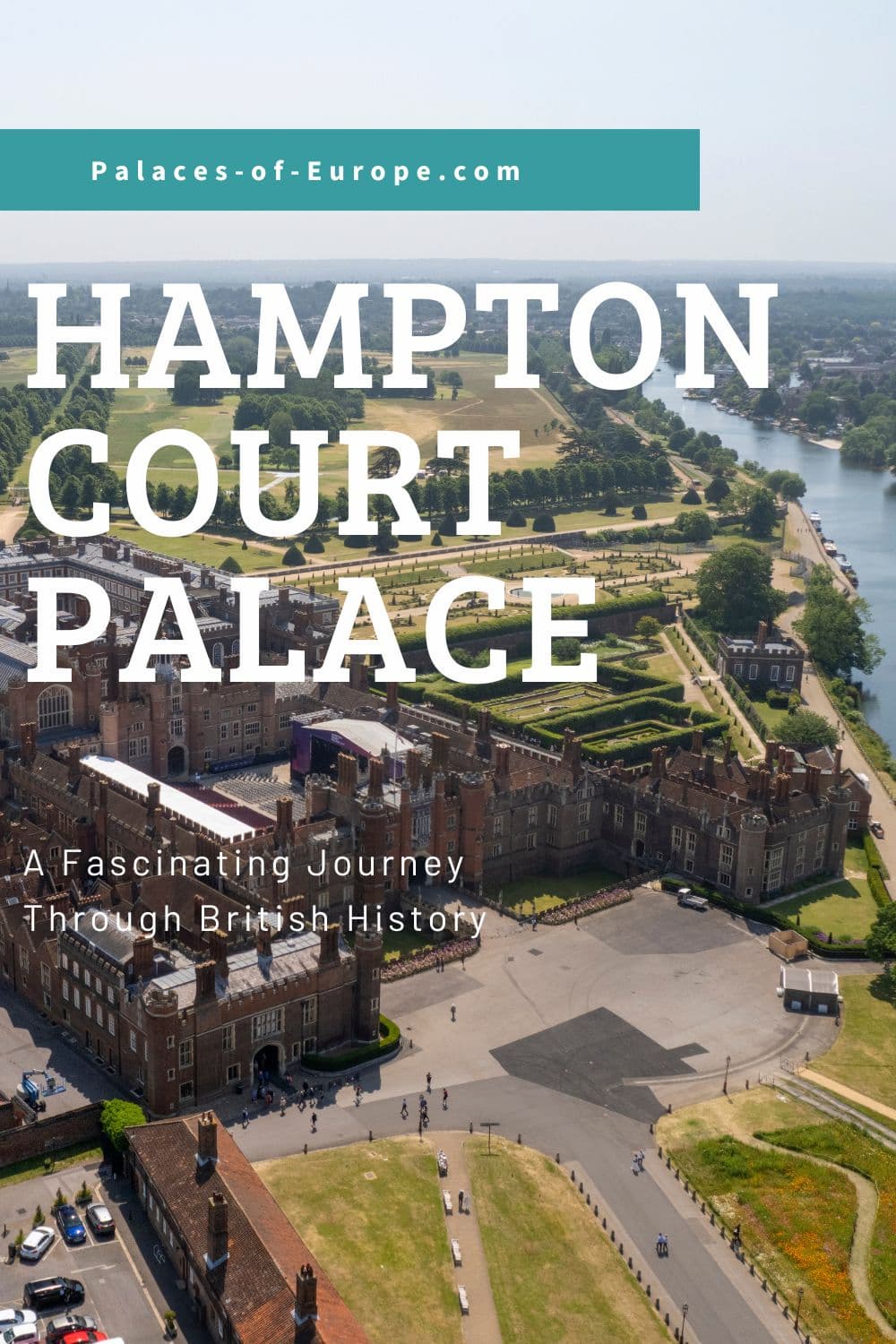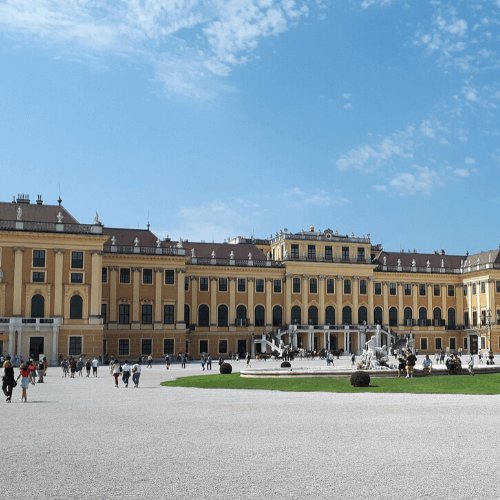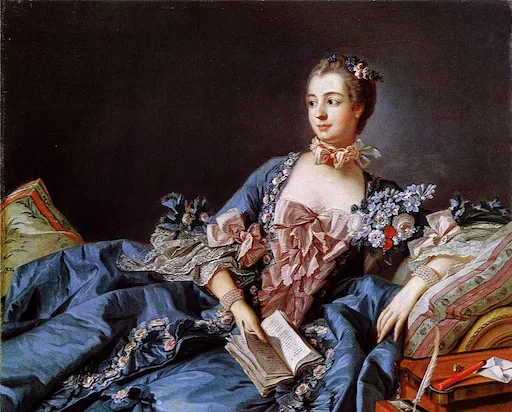Hampton Court Palace
A Fascinating Journey Through British History
Hampton Court Palace is one of the most iconic and well-preserved palaces in England. It is a must-see for anyone interested in British history, culture, and architecture. The palace was built in the 16th century by King Henry VIII and served as a royal residence for over 300 years.
Hampton Court Palace was the favorite home of King Henry VIII. Anne Boleyn was crowned Queen of England at Hampton Court Palace in 1533.
The Palace was used as a military hospital during the English Civil War and it was a popular summer residence for Queen Victoria and Prince Albert.
Hampton Court Palace is one of the most popular tourist attractions in the United Kingdom, known for its beautiful gardens, historic buildings, and art collections.
DISCLOSURE: I get commissions for purchases made through some of the links in this article.
How Hampton Court Came to King Henry VIII
You might chuckle at this, but did you know that Hampton Court was actually not built by Henry VIII, but by his friend and favourite, Cardinal Thomas Wolsey? Wolsey began construction on the palace in 1514, but it was eventually confiscated by the king in 1529. In Fact, when Wolsey fell from favour, he "gifted" the palace to Henry in 1528 to appease his wrath. Talk about a parting gift!
It did not safe him though, Wolsey was also accused of corruption and treason. He was arrested in 1530 and charged with treason. He died on November 29, 1530, while on his way to London to stand trial. It is believed that he died of natural causes, but there are also rumors that he committed suicide.
Tudor Court Life in Hampton Court Palace
Henry VIII expanded and renovated the palace, making it one of his favourite residences.
Life in this Tudor palace was quite a whirlwind of masquerades, feasts, and politics. Although it might sound glamorous, courtiers were constantly scrambling to keep or elevate their positions. The flamboyant court life Henry enjoyed was renowned throughout Europe, making the palace an emblem of his wealth and power.
The palace was the setting for many important events during Henry VIII's reign. It was here that the king married five of his six wives and held lavish courtly entertainments. Hampton Court Palace was also a center of power and intrigue, and it played a significant role in the English Reformation.
Unexpected Evidence of the Six Wives of Henry VIII
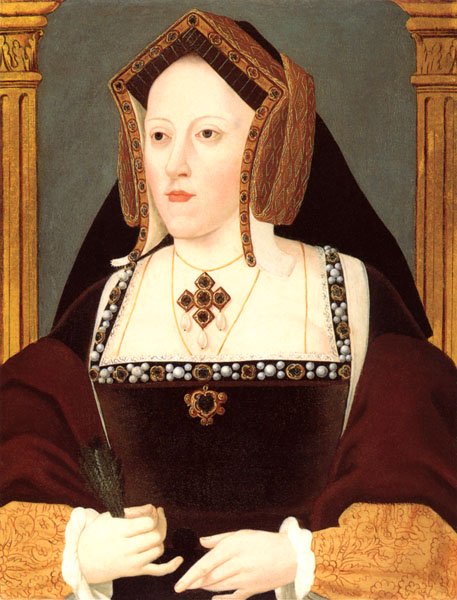
Hampton Court is the only palace to have housed all of Henry VIII's six wives. While visiting, you can spot remnants of the lives they led.
Catherine of Aragon was the first wife of King Henry VIII, and they were married from 1509 to 1533. Hampton Court Palace was one of Henry VIII's favorite residences, and he and Catherine spent a lot of time there.
Catherine of Aragon was a popular figure at court and was known for her intelligence, piety, and kindness. She was also a skilled musician and artist. Catherine of Aragon was a devoted wife and mother, and she bore Henry VIII six children, although only one, Mary I, survived to adulthood.
In 1527, Henry VIII began an affair with Anne Boleyn. He wanted to marry Anne, but Catherine of Aragon refused to grant him a divorce. Henry VIII eventually had the marriage annulled by the Pope, but Catherine of Aragon never accepted the annulment. She continued to regard herself as the rightful Queen of England until her death in 1536.
Despite the fact that her marriage to Henry VIII was annulled, Catherine of Aragon was allowed to remain at Hampton Court Palace for several years. However, she was eventually forced to leave the palace and move to Kimbolton Castle, where she died in 1536.
Above this door is a stone arch decorated with Tudor Roses on the right for King Henry and Spanish pomegranates on the left, the symbol for Catherine of Aragon, the first wife of Henry VIII.
Navigate Google indoor maps:
Clicking the square on the right will get you full screen,
Click and hold for looking arond,
Click the arrows to move forward to different directions.
You can also use the zoom buttons to zoom in and out of the map, and the search bar to search for specific locations within the building.
- Anne Boleyn was the second wife of Henry VIII and the mother of Queen Elizabeth I. She was a controversial figure, but she also had a significant impact on Hampton Court Palace. Anne Boleyn was responsible for commissioning many of the palace's most iconic features, including the Great Hall and the Privy Apartments. She also introduced many new fashions and customs to the English court.
The Great Hall was decorated with Anne's initials and coat of arms. When she fell out of grace and lost her head, Henry also tried to chop off all the evidence of her existence from his palace. This had to be done in a hurry, as Anne Boleyn was executed on May 19, 1536. Henry VIII married Jane Seymour on May 30, 1536.
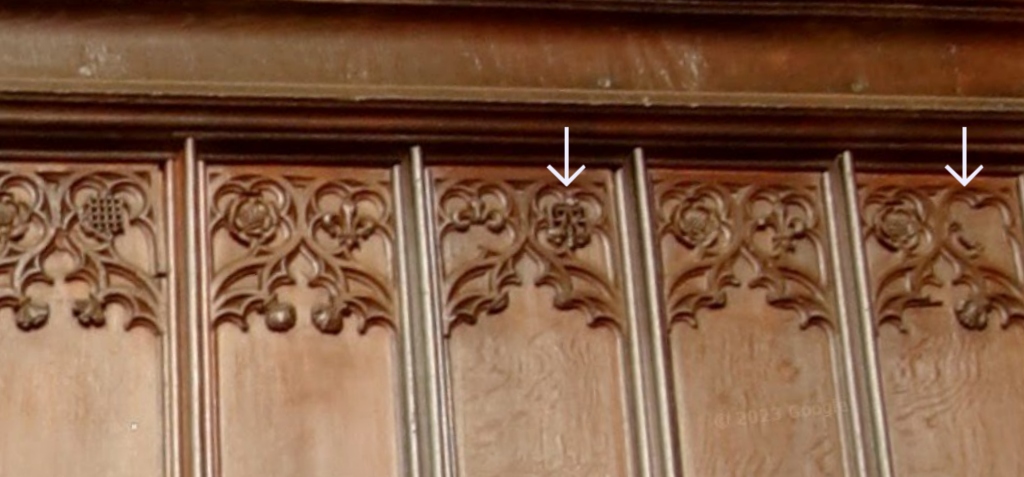
No wonder the carpenters missed a few spots. You can see the intertwined H and A on this wooden panelling, where on the right it is gone, but on the left, it is still there!
Anne Boleyn's symbol - a falcon - is also still carved in the Great Hall's ceiling.
- Jane Seymour was the third wife of Henry VIII and the mother of King Edward VI. She was a popular figure at court and was known for her piety and kindness. Jane Seymour died just 12 days after giving birth to Edward VI at Hampton court, but her legacy can still be seen around the Palace. The palace's chapel is dedicated to Jane Seymour, and her tomb is located in the choir.
The chapel is also significant because of the baptism of Edward VI, Jane's son. The ceremony was a lavish affair, attended by many of the most important people in England. It was the first time that a child of the English monarch had been baptized in the Protestant faith. The ceremony was also a symbol of Henry VIII's break with the Catholic Church.
- Anne of Cleves was the fourth wife of Henry VIII. She was married to the king for just six months before he had the marriage annulled. Anne of Cleves was not a popular figure at court, but she did leave her mark on Hampton Court Palace. The palace's Anne of Cleves Gatehouse is named after her.
- Katherine Howard was the fifth wife of Henry VIII. She was a young and beautiful woman, but she was also unfaithful to the king. Katherine Howard was executed for treason in 1542, but her legacy can still be seen at Hampton Court Palace. Her initials, "KH," and her coat of arms, a lion rampant, can be found carved into the walls and doorways of Hampton Court Palace. These carvings are located throughout the palace, including in the Great Hall, the Privy Apartments, and the Chapel Royal.
- Catherine Parr was the sixth and final wife of Henry VIII. She was an intelligent and compassionate woman, and she helped to care for the king during his final years. Catherine Parr survived Henry VIII and went on to marry Thomas Seymour. She died in 1548, but her legacy can still be seen at Hampton Court Palace. The palace's Catherine Parr Apartments are named after her.
A True Blend of Architectural Styles
After the death of Henry VIII, Hampton Court Palace continued to be used by the British monarchy. It was a popular residence for Queen Elizabeth I, who held many grand courtly events at the palace. Hampton Court Palace was also used by subsequent monarchs, including King Charles I, King William III, and Queen Mary II.
The palace is an unusual blend of Tudor and later, Baroque architecture. When William III took the throne, he had sections of the palace remodeled, ultimately resulting in a fascinating blend of styles.
Many monarchs added their visionary ideas to Hampton Court Palace, quite literally leaving a mark on its architecture. Charles II and George II, while not architects themselves, both had renovations done on the palace under their orders.
In the 18th century, Hampton Court Palace fell out of favor with the British monarchy. King George II was the last monarch to live at the palace. He died in 1760.
Hampton Court Palace was opened to the public in 1838 by Queen Victoria. She ordered the gates of the palace to be "thrown open to all her subjects" as an early act of generosity. Visitors flocked to enjoy the stunning palace architecture, get lost in the maze and relax in the beautiful gardens.
The Ghosts of Hampton Court
Hampton Court Palace is one of the most haunted places in England, with a long and rich history of ghostly sightings. Many of the palace's ghosts are said to be the spirits of former residents and visitors, including Henry VIII's wives Catherine Howard and Anne Boleyn.
Catherine Howard, Henry VIII's fifth wife, is said to haunt the Haunted Gallery, where she was last seen fleeing from the guards who came to arrest her for treason. Visitors to the Haunted Gallery often report hearing her screams and seeing her ghost.
Catherine's ghost is busy, as It is said that her ghost also haunts the Haunting Clock because it was near the clock that she was last seen before being arrested. The clock is located in the State Apartments at Hampton Court Palace.
Anne Boleyn, Henry VIII's second wife, is another of the palace's most famous ghosts. She is said to haunt the Queen's Gallery, where she was last seen before being executed in the Tower of London. Visitors to the Queen's Gallery often report seeing her ghost and hearing her footsteps.
Other ghosts at Hampton Court Palace include:
The Grey Lady: The Grey Lady is said to be the ghost of Sybil Penn, a nurse to Edward VI and Elizabeth I. She is said to haunt the Tudor Apartments, where she can often be seen walking the corridors.
The Headless Man: The Headless Man is said to be the ghost of a soldier who was executed during the Civil War. He is said to haunt the Long Gallery, where he can often be seen walking without a head.
The Jester: The Jester is said to be the ghost of a jester who served Henry VIII. He is said to haunt the Great Hall, where he can often be heard laughing.
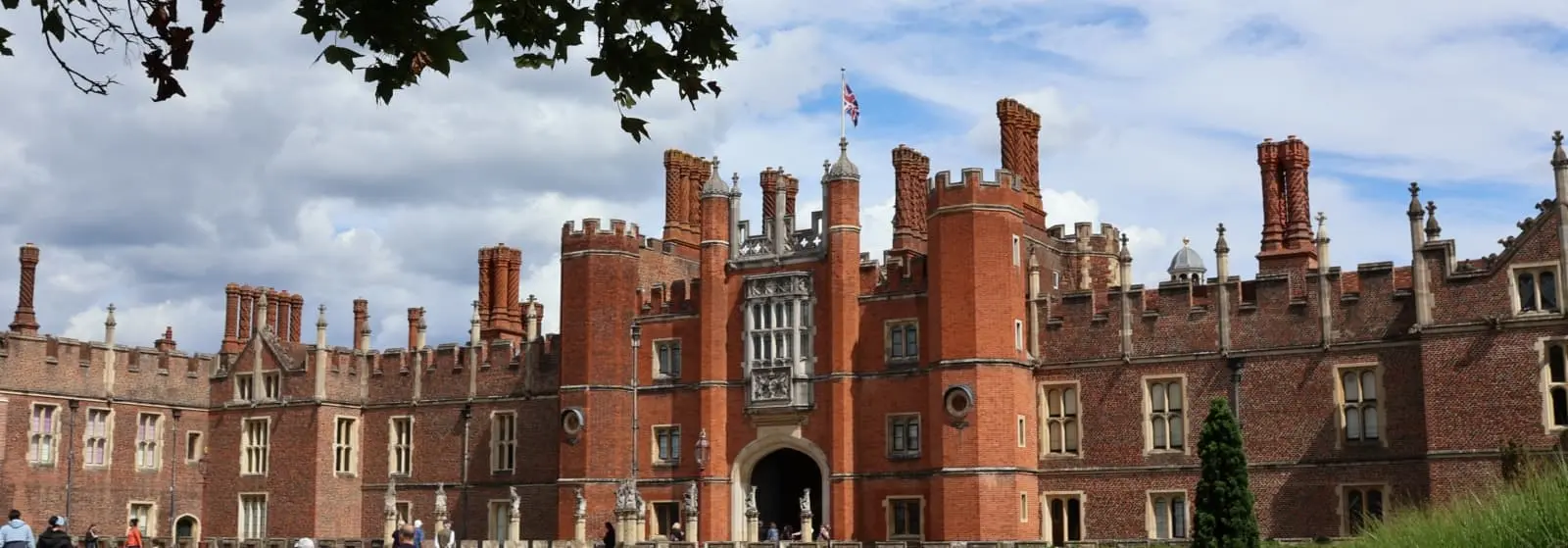
Must-see features when you visit Hampton Court Palace
The Tudor Kitchens in Hampton Court Palace offer a fascinating insight into servant life. They cover an area of over 3,000 square feet and were used to prepare meals for over 600 people every day. The kitchens were divided into a number of different rooms, each with its own specific purpose. For example, there was a room for baking, a room for roasting, and a room for boiling.
Did you know Hampton Court Palace had a dedicated Chocolate Kitchen? Yes, you heard it right, a room just for brewing heavenly cups of chocolate! Thomas Tosier, George I’s chocolate-maker, whipped up the most divine concoctions in this room.
The palace's stunning gardens, covering an astonishing 60 acres, showcase a mix of styles.
- Visit the Great Vine (planted in 1769!)
- The Privy Garden is a formal garden that was laid out by Henry VIII in the 16th century. It is decorated with fountains, statues, and flowerbeds.
- The Great Fountain Garden is a large garden that was laid out by William III in the 17th century. It is decorated with a number of fountains, including the Great Fountain, which is the largest fountain in England.
- The Rose Garden is a beautiful garden that is home to over 1,000 roses of different varieties.
- The Maze is a complex maze that was laid out by William III in the 17th century. It is one of the oldest and most famous mazes in England.
- The Tiltyard is a large courtyard that was used for jousting tournaments in the Tudor period. Today, it is used for concerts and other events.
- The Game of Real Tennis -Hampton Court Palace's tennis court, established in 1628, is a sight to see. This sport, played by Henry VIII, is still played here today.
(Virtual) tour of Hampton Court Palace
When you plan to visit the palace, go to the official website of Hampton Court Palace for up-to-date opening hours and ticket prices.
If you are unable to visit Hampton Court Palace in person, you can take a virtual tour of the palace on the Historic Royal Palaces website. The virtual tour allows you to explore the state rooms, the gardens, and the maze. You can also learn about the palace's history and architecture.
You can look around the Palace in Google streetview, just turn your mouse around in this image. A virtual tour of Hapmton Court Palace is available on Google artsandculture.
Starring Hampton Court
Hampton Court Palace is a popular filming location because of its stunning architecture and historical atmosphere. The palace has been used to represent a variety of different time periods and locations in films and TV shows.
Here are some examples with a link to a source where you can watch them:
Movies:
The Favourite (2018):
The court dance scene takes place in the oak walled, black-and-white chequered floored Marble Hall at Hampton Court Palace.
The Marble Hall is a large and impressive room that was built by Henry VIII in the 16th century. It is decorated with marble columns, statues, and paintings. The Marble Hall was often used for grand events, such as balls and banquets.
Pirates of the Caribbean: On Stranger Tides (2011: In the trial scene in Pirates of the Caribbean: On Stranger Tides, Captain Jack Sparrow is brought before King George II (Richard Griffiths) to be tried for his crimes. The Fountain Garden is a large and beautiful garden that was laid out by William III in the 17th century. It is decorated with fountains, statues, and flowerbeds
The Young Victoria (2009): The coronation of Queen Victoria: The coronation of Queen Victoria scene takes place in the Great Hall at Hampton Court Palace.
The Duchess (2008): Hampton Court Palace was used to film the scene in which Queen Anne is crowned.
Shakespeare in Love (1998): In the balcony scene in Shakespeare in Love, William Shakespeare (Joseph Fiennes) and Viola de Lesseps (Gwyneth Paltrow) confess their love for each other. The balcony scene takes place in the Haunted Gallery at Hampton Court Palace.
TV shows:
Bridgerton (2020-present): If you are a fan of Bridgerton, I highly recommend visiting Hampton Court Palace. You will be able to see many of the locations that were used in the show, and you will get to experience the beauty and grandeur of Hampton Court Palace for yourself.
The Great (2020-present): Hampton Court Palace was used to represent the Winter Palace in St. Petersburg, Russia, and the Tiltyard was used to represent the Red Square in Moscow!
Wolf Hall (2015): Hampton Court Palace was used to represent a number of different locations in Wolf Hall, including the King's Privy Chamber, the Council Chamber, and the Great Hall.
The Tudors (2007-2010):
Surprisingly, very few scenes of the TV series The Tudors were actually filmed on location at Hampton Court Palace. The makers of The Tudors used a variety of techniques to create the illusion that the show was filmed at Hampton Court Palace. For example, they used computer-generated imagery (CGI) to add Hampton Court Palace to scenes that were actually filmed in Ireland. Additionally, they filmed some scenes at other locations that resembled Hampton Court Palace, such as Killruddery House in Ireland.
